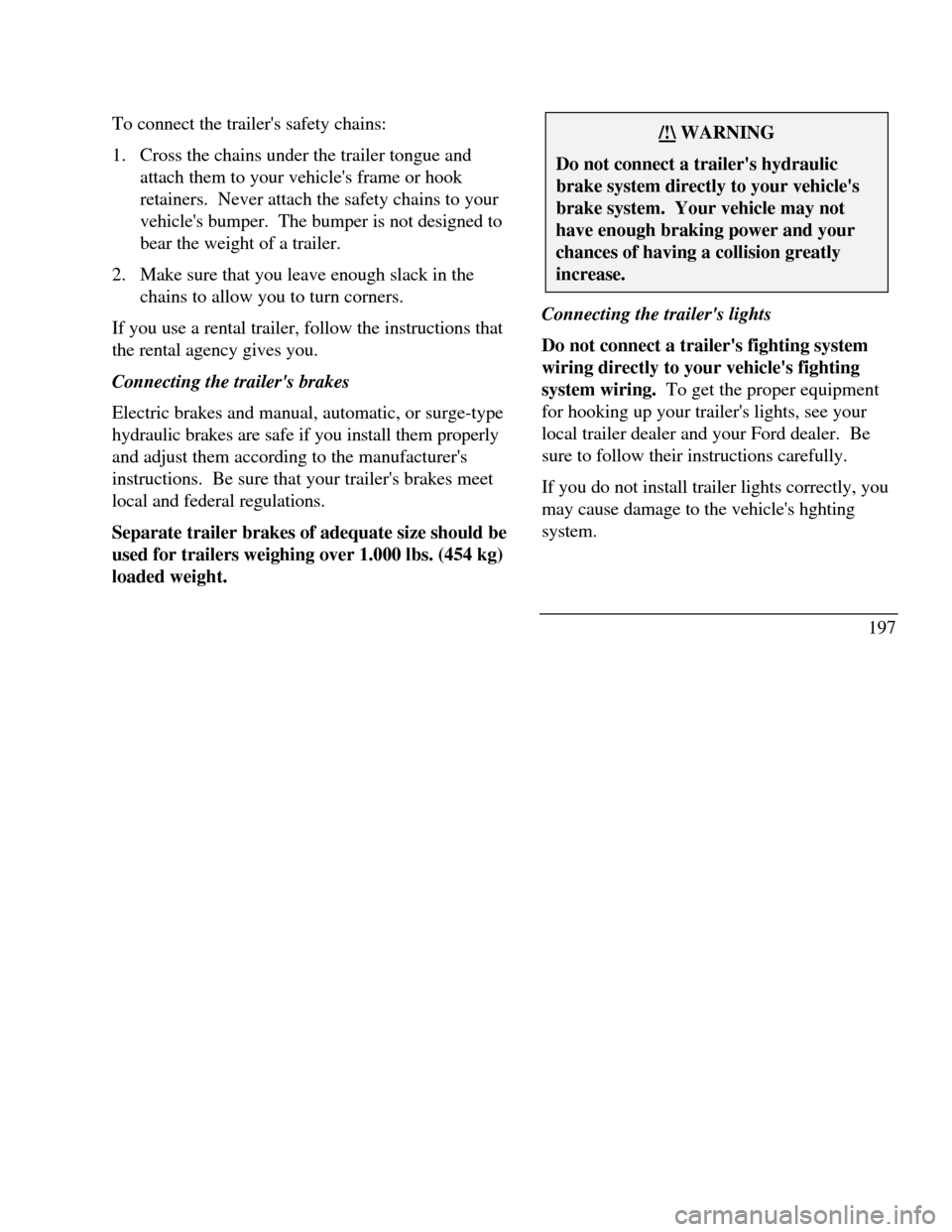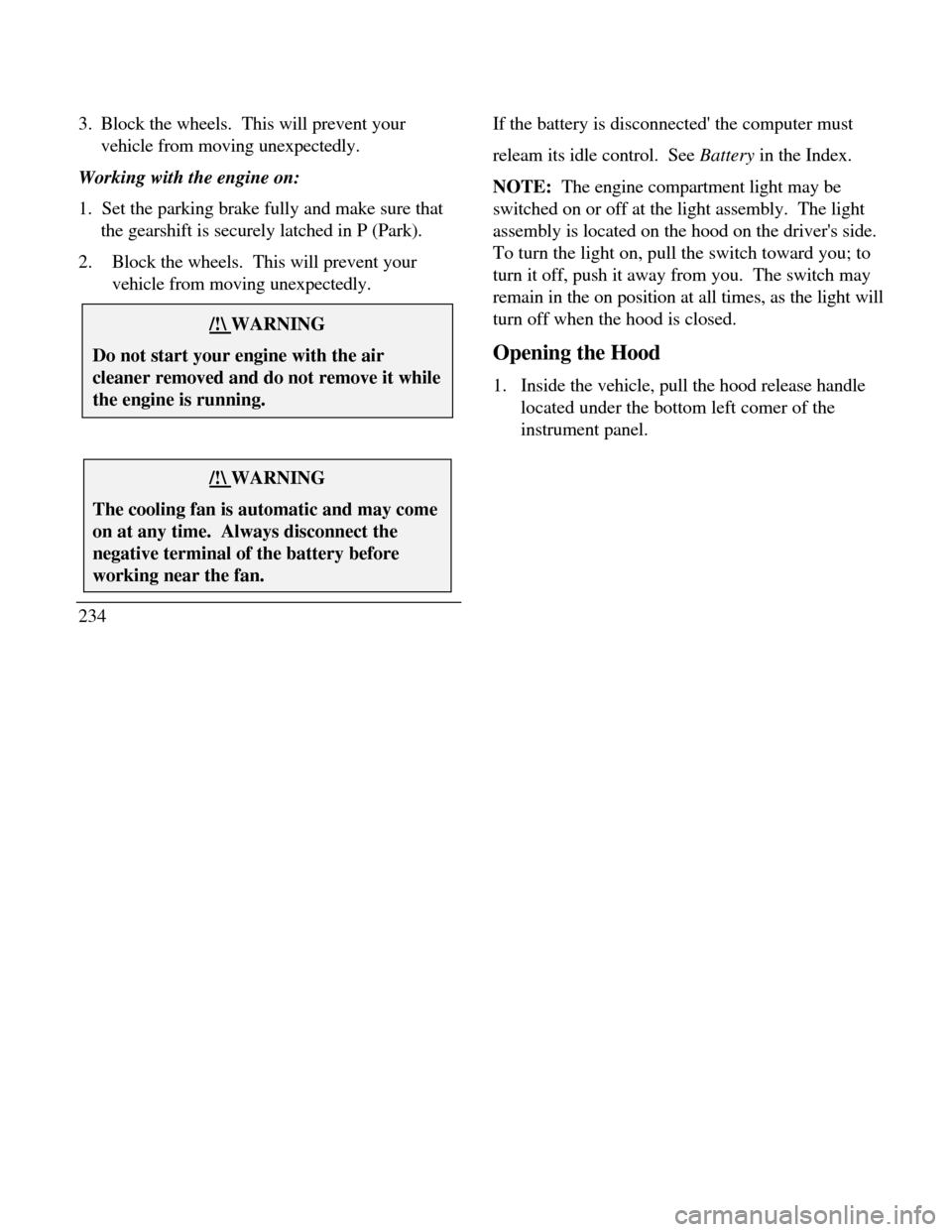Page 188 of 320

In general, this system improves your vehicle's
stability and acceleration performance when road
conditions warrant. Traction ControlÔ is fully
effective at all vehicle speeds.
If the Traction ControlÔ system is cycled
excessively, the brake portion of the system will shut
down to prevent the front brakes from overheating.
A limited Traction ControlÔ function using engine
torque will still control wheels from spinning. A
cooling down period is required to prevent damage
to the brakes. This time period varies and depends
on brake usage during the cooling down period.
Anti-Lock braking is not affected and will function
normally during the cool down period.
After the cool down period, the full Traction
ControlÔ' function is restored.Steering Your Vehicle
Your vehicle comes with power steering.
Power steering uses energy from the engine to
help steer your vehicle.
If the amount of effort needed to steer your
vehicle changes, check your steering effort
selection in the Message Center. If this is not
the problem, have the power steering system
checked. If the power steering system breaks
down (or if the engine is turned off), you can
steer the vehicle manually but it takes more
effort.
The steering system in your vehicle is speed
sensitive. This means that the steering effort is
light for parking and heavier for highway
driving. However, if you have to swerve
around an object or another vehicle, your
steering will have full power assist.
185
Page 190 of 320

Brakes
Applying the Brakes
Your vehicle has anti-lock disc brakes on all four
wheels. They adjust automatically as the brake pads
wear down.
When you press down hard on the brake pedal, the
wheels will not lock and slide. The Anti-lock Brake
System (ABS) automatically starts releasing and
reapplying the front brakes independently and the
rear brakes together whenever your wheels start to
lock. When this happens, you will feel the brake
pedal pulsate. This is an indication that the ABS
system is working correctly and is normal.
Each time you turn the ignition key to the ON
position, the anti-lock brake system will function
through one test cycle. When this happens, the ANTI-
LOCK light will come on for up to five seconds and a
clunk may be felt in the pedal. If the light stays on
longer than five seconds, shut off theengine and restart. If it remains on, it means the
anti-lock brake system is disabled and should be
serviced immediately to restore the benefits of
the anti-lock feature. Normal braking is not
affected unless the brake warning light is also lit.
The And-lock Brake System has self-check
capabilities. As described above, the system
turns on the ANTI-LOCK light each time you
start your engine. After the engine is started
and the ANTI-LOCK light turns off, the system
performs another test the first time the vehicle
reaches 14 m.p.h. (22 km/h). The system turns
on the ABS pump motor for approximately 1/2
second. At this time, a mechanical noise may
be heard. This is a normal part of the self-
check feature. If a malfunction is found during
this check the ANTI-LOCK light will come on.
Do not drive with your foot resting on the
brake pedal; you will wear out the linings and
increase your vehicle's stopping distance.
Brake rotor damage may also eventually occur.
187
Page 191 of 320

NOTE: If you are driving down a long or steep hill,
shift to a lower gear and do not apply your brakes
continuously. If you apply your brakes continuously,
they may overheat and become less effective.
Occasional brake squeal during light to moderate
stops does not affect the function of the brake system
and is normal. However, if the squeal becomes
louder or more frequent, have your brakes inspected
by your dealer or a qualified service technician.
Ford Motor Company has not found any detrimental
effects of popular mobile radio transmitting
equipment installed on vehicles with the anti-lock
brake system, if the equipment is installed according
to the manufacturer's instructions. However, if
mobile radio transmitting
188equipment is installed in your vehicle and, if
either the anti-lock brake system cycles or the
ANTI-LOCK light comes on at any time other
than right after you turn the key to the ON
position or during a sudden stop, have your
mobile radio dealer inspect the installation.
Parking Brake
The parking brake should be used whenever
you park your vehicle.
The parking brake is suspended just below the
lower left corner of the instrument panel.
To set the parking brake while parking your
vehicle, apply the brake pedal with your right
foot and hold it while you push the parking
brake down firmly and fully with your left foot.
Page 192 of 320
The Parking brake/!\ WARNINGAlways set the Parking brake fully andmake sure that the gearshift is securelylatched in P (Park)./!\ WARNINGIf the parking brake is fully released, butthe Brake System light-remains on, havethe brakes checked immediately. Theymay not be working properly./!\ WARNINGTo prevent personal injury, do not releasethe parking brake while outside thevehicle.189
Page 193 of 320

You have an automatic release for the parking brake.
The parking brake should automatically unlock when
you move the gearshift to any forward gear while the
engine is running. However, the automatic release
does not work when the gearshift is in reverse,
neutral or park.
To manually release the parking brake, pull the
BRAKE RELEASE handle located on the lower left
comer of the instrument panel. The Brake Warning
Light will illuminate if the parking brake is not fully
released when the engine is running.
The parking brake is not designed to stop a moving
vehicle, but you can use the parking brake to stop
your vehicle in an emergency if the normal brakes
fail. However, since the parking brake applies only
the rear brakes, the stopping distance will increase
greatly and the handling of your vehicle will be
adversely affected.
190Always check the Brake Warning light each
time you start your engine. Driving with the
parking brake on will cause the brakes to wear
out quickly and will reduce the fuel economy.
Driving Under Special Conditions
Tips for Safe Driving
As with any new vehicle, yours may drive and
handle differently from your previous vehicle.
Use care until you become accustomed to its
various features and driving characteristics.
Operate your vehicle within reasonable limits.
Sudden acceleration, deceleration, turning, or
combinations of these maneuvers can cause a
vehicle to behave differently than anticipated.
Page 200 of 320

To connect the trailer's safety chains:
1. Cross the chains under the trailer tongue and
attach them to your vehicle's frame or hook
retainers. Never attach the safety chains to your
vehicle's bumper. The bumper is not designed to
bear the weight of a trailer.
2. Make sure that you leave enough slack in the
chains to allow you to turn corners.
If you use a rental trailer, follow the instructions that
the rental agency gives you.
Connecting the trailer's brakes
Electric brakes and manual, automatic, or surge-type
hydraulic brakes are safe if you install them properly
and adjust them according to the manufacturer's
instructions. Be sure that your trailer's brakes meet
local and federal regulations.
Separate trailer brakes of adequate size should be
used for trailers weighing over 1.000 lbs. (454 kg)
loaded weight./!\ WARNINGDo not connect a trailer's hydraulicbrake system directly to your vehicle'sbrake system. Your vehicle may nothave enough braking power and yourchances of having a collision greatlyincrease.Connecting the trailer's lights
Do not connect a trailer's fighting system
wiring directly to your vehicle's fighting
system wiring. To get the proper equipment
for hooking up your trailer's lights, see your
local trailer dealer and your Ford dealer. Be
sure to follow their instructions carefully.
If you do not install trailer lights correctly, you
may cause damage to the vehicle's hghting
system.
197
Page 201 of 320

Driving While You Tow
Be especially careful when driving while you tow a
trailer. Never drive faster than 45 mph (70 km/h)
when you tow in hilly country on hot days. Also,
anticipate stops so that you can brake gradually.
Towing a trailer increases the load on the engine and
transaxle, particularly in hilly country and with
heavier trailers. Under these conditions you may
experience an excessive amount of shifting between
Overdrive and Third gears. Moving the shift selector
to D (Overdrive Lockout) will keep this from
happening and will provide better engine braking.
When driving in less hilly country or with a lighter
trailer load. you may move the gearshift selector
lever to (Overdrive) without experiencing
excessive shifting.
198When driving down steep hills, you should put
the gearshift selector lever in the I (First)
position to shift the transaxle into second gear.
This will provide additional engine braking.
The automatic transaxle will automatically
downshift to the proper gear for driving up a
grade.
If you use the speed control while you are
towing on very long, steep grades, the speed
control may shut off.
Servicing your vehicle if you tow
If you tow a trailer for a long distance, your
vehicle will need to be serviced more frequently
than usual. See the Maintenance Schedule and
Record booklet.
Page 236 of 320

3.Block the wheels. This will prevent your
vehicle from moving unexpectedly.
Working with the engine on:
1. Set the parking brake fully and make sure that
the gearshift is securely latched in P (Park).
2.Block the wheels. This will prevent your
vehicle from moving unexpectedly./! WARNINGDo not start your engine with the aircleaner removed and do not remove it whilethe engine is running./! WARNINGThe cooling fan is automatic and may comeon at any time. Always disconnect thenegative terminal of the battery beforeworking near the fan.234If the battery is disconnected' the computer must
releam its idle control. See Battery in the Index.
NOTE: The engine compartment light may be
switched on or off at the light assembly. The light
assembly is located on the hood on the driver's side.
To turn the light on, pull the switch toward you; to
turn it off, push it away from you. The switch may
remain in the on position at all times, as the light will
turn off when the hood is closed.
Opening the Hood
1. Inside the vehicle, pull the hood release handle
located under the bottom left comer of the
instrument panel.